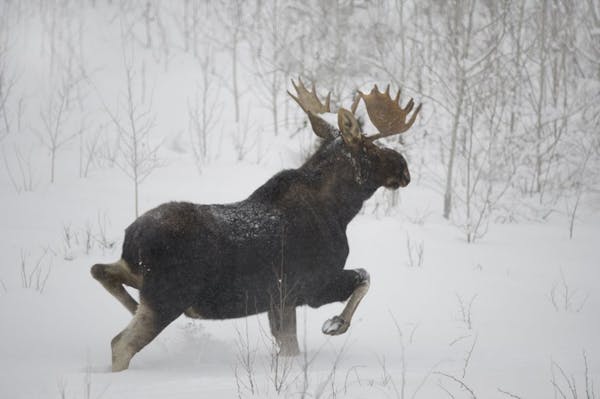Resort owner Jerry Barthel witnessed the collapse of the Upper Red Lake walleye fishery in the 1990s, the closure of the lake to walleye fishing, and the ice-angler frenzy when huge crappies briefly filled the walleye void.
The monster crappies -- and the long line of anglers' vehicles at Barthel's lake access -- are mostly gone. But now he and others are seeing the continued resurgence of Upper Red Lake's walleye fishery. Since the lake was reopened to walleye fishing in 2006, it has been attracting thousands of anglers.
The walleye population is at a record high, so regulations have been relaxed this winter to give anglers a better chance of keeping fish for the fry pan. And with ice thick enough to walk on, anglers already are converging.
"It was crazy over the weekend -- people were everywhere," said Barthel, who runs Rogers' Campground and RV Park on the south shore of Upper Red, and provides lake access. He and others are ecstatic over the walleye rebound.
"Our phone was ringing off the hook," said Tim Waldo, owner of West Wind Resort. His lodge was full recently, so some anglers slept in his ice-fishing houses still parked on the shore of the sprawling lake.
With only 1 to 2 inches of snow on the lake, and temperatures in the single digits, Waldo and Barthel say it won't be long before trucks can haul those permanent ice-fishing houses onto the ice, kicking the season into high gear. And they believe the high walleye population and more liberal slot limit will attract even more anglers this winter.
"The walleye fishing the last few years has been outstanding -- the best it's ever been," said Barthel, who has owned his resort for 19 years.
He's not exaggerating.
The Department of Natural Resources' gill-net walleye survey last fall found up to 60 fish-per-net -- the highest since the agency began the survey 30 years ago. To put that in perspective, the average on Lake of the Woods, where fishing also has been excellent, is 18 fish-per-net, and at Leech Lake, which also has undergone a walleye resurgence, the average is 9.4 fish-per-net.
At Upper Red Lake, fisheries biologists say there's an assortment of different-sized fish, which underscores the healthy reproduction.
"The walleye fishery is thriving," said Henry Drewes, the DNR's regional fisheries manager. "Given the regulation change and the status of fishery, I would expect it's going to be extremely busy winter up there."
Collapse to recovery
The collapse of the walleye fishery on Red Lake -- two huge basins, Upper Red Lake and Lower Red Lake -- was well-documented. Commercial netting by the Red Lake Band of Chippewa and overfishing nearly wiped out the walleyes by the early 1990s. The DNR and band closed both bodies to fishing, and stocked millions of walleye fry over several years to jump-start its recovery.
Officials had thought it might take a decade or longer for the lake to recover. Remarkably, it was reopened in just seven years.
"We knew Red Lake was a walleye factory, but I can't say I would have predicted this," said Gary Barnard, DNR area fisheries manager. "It's exceeded my expectations."
And just about everyone else's.
Before the walleye rebound, crappies temporarily filled the void, aided by historic reproduction in 1995. For several years, unprecedented numbers of anglers stormed the lake to catch 12- to 15-inch slabs. Anglers and businesses never saw anything like it -- and likely won't again.
"In the crappie days, we had 500 vehicles go through here one Saturday," said Barthel. "Now on a good weekend, we don't get even half of that. I don't think we'll ever see that kind of traffic."
Anglers still catch the occasional nice crappie, but the numbers are no longer there.
"It occurred during unprecedented low walleye abundance," Drewes said. "If we do our job right, it won't happen again."
A walleye surplus
The last major walleye fry stocking was in 2003.
"Since then, we've documented excellent natural reproduction," Drewes said. "We have 12 different age classes of fish. Growth rates have improved. The condition of the fish -- their plumpness -- has improved. They are impressive fish."
And officials want anglers to take more of them.
The Red Lake Band has resumed limited commercial harvest of walleyes, mostly by hook-and-line, but also with gill nets, which aren't used during the spring spawning season. Drewes said the state and the band are committed to protecting the fishery and not overharvesting walleyes.
Under a joint agreement, the band, which controls 237,000 acres, including all of Lower Red Lake and more than half of Upper Red Lake, can harvest 415,000 to 830,000 pounds of walleyes. Last year, the band took about 750,000 pounds.
Anglers on the 48,000 acres of state-controlled Upper Red Lake can take 84,000 to 168,000 pounds. Last year, they took about 72,000 pounds -- which is why the DNR has relaxed the slot limit.
"There's no reason to not allow anglers to harvest a few more fish," Barnard said. "People are pretty excited about it."
Doug Smith • dsmith@startribune.com Twitter: @dougsmithstrib
Carrasco pitches solid into the 6th inning and the Guardians beat the Red Sox 5-4
Kansas adds AJ Storr after he led Wisconsin in scoring this season

The Twins sell tickets with all-you-can-eat classic concession fare. Are they worth it?
Butler, Williamson injuries are part of story for Heat-Bulls and Kings-Pelicans play-in finales

